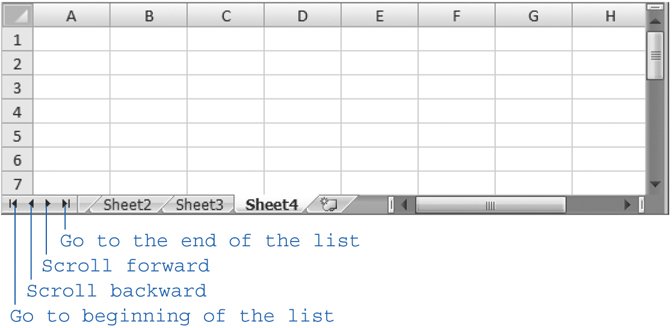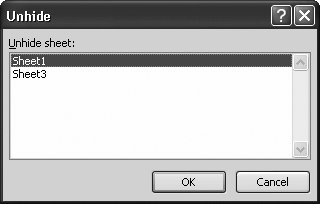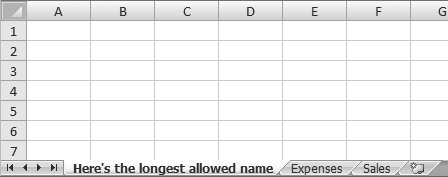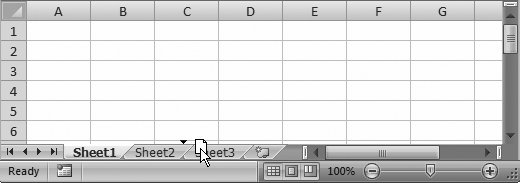Section 4.1. Worksheets and Workbooks
4.1. Worksheets and WorkbooksMany workbooks contain more than one table of information. For example, you might have a list of the items you've purchased over two consecutive years . You might find it a bit challenging to arrange these different tables. You could stack them (Figure 4-1) or place them side by side (Figure 4-2), but neither solution is perfect. Most Excel masters agree that the best way to arrange separate tables of information is to use separate worksheets for each table. When you create a new workbook, Excel automatically fills it with three blank worksheets named Sheet1, Sheet2, and Sheet3. Often, you'll work exclusively with the first worksheet (Sheet1), and not even realize that you have two more blank worksheets to play withnot to mention the ability to add plenty more.
To move from one worksheet to another, you have a few choices:
Excel keeps track of the active cell in each worksheet. That means if you're in cell B9 in Sheet1, and then move to Sheet2, when you jump back to Sheet1 you'll automatically return to cell B9.
Tip: Excel includes some interesting viewing features that let you look at two different worksheets at the same time, even if these worksheets are in the same workbook. You'll learn more about custom views in Chapter 6. 4.1.1. Adding, Removing, and Hiding Worksheets When you open a fresh workbook in Excel, you automatically get three blank worksheets in it. You can easily add more worksheets. Just click the Insert Worksheet button, which appears immediately to the right of your last worksheet tab (Figure 4-4). You can also use the Home If you continue adding worksheets, you'll eventually find that all the worksheet tabs won't fit at the bottom of your workbook window. If you run out of space, you need to use the scroll buttons (which are immediately to the left of the worksheet tabs) to scroll through the list of worksheets. Figure 4-5 shows the scroll buttons .
Tip: If you have a huge number of worksheets and they don't all fit in the strip of worksheet tabs, there's an easier way to jump around. Right-click the scroll buttons to pop up a list with all your worksheets. You can then move to the worksheet you want by clicking it in the list. Removing a worksheet is just as easy as adding one. Simply move to the worksheet you want to get rid of, and then choose Home Warning: Be careful when deleting worksheets, as you can't use Undo (Ctrl+Z) to reverse this change! Undo also doesn't work to reverse a newly inserted sheet. Excel starts you off with three worksheets for each workbook, but changing this setting's easy. You can configure Excel to start with fewer worksheets (as few as one), or many more (up to 255). Select Office button Note: Although you're limited to 255 sheets in a new workbook, Excel doesn't limit how many worksheets you can add after you've created a workbook. The only factor that ultimately limits the number of worksheets your workbook can hold is your computer's memory. However, modern day PCs can easily handle even the most ridiculously large, worksheet stuffed workbook. Deleting worksheets isn't the only way to tidy up a workbook or get rid of information you don't want. You can also choose to hide a worksheet temporarily. When you hide a worksheet, its tab disappears but the worksheet itself remains part of your spreadsheet file, available whenever you choose to unhide it. Hidden worksheets also don't appear on printouts. To hide a worksheet, right-click the worksheet tab and choose Hide. (Or, for a more long-winded approach, choose Home To redisplay a hidden worksheet, right-click any worksheet tab and choose Unhide. The Unhide dialog box appears along with a list of all hidden sheets, as shown in Figure 4-6. You can then select a sheet from the list and click OK to unhide it. (Once again, the ribbon can get you the same windowjust point yourself to Home
4.1.2. Naming and Rearranging WorksheetsThe standard names Excel assigns to new worksheetsSheet1, Sheet2, Sheet3, and so onaren't very helpful for identifying what they contain. And they become even less helpful if you start adding new worksheets, since the new sheet numbers don't necessarily indicate the position of the sheets, just the order in which you created them. For example, if you're on Sheet 3 and you add a new worksheet (by choosing Home
Note: Excel has a small set of reserved names that you can never use. To witness this problem, try to create a worksheet named History. Excel doesn't let you because it uses the History worksheet as part of its change tracking features. Use this Excel oddity to impress your friends . Sometimes Excel refuses to insert new worksheets exactly where you'd like them. Fortunately, you can easily rearrange any of your worksheets just by dragging their tabs from one place to another, as shown in Figure 4-8.
Tip: You can use a similar technique to create copies of a worksheet. Click the worksheet tab and begin dragging, just as you would to move the worksheet. However, before releasing the mouse button, press the Ctrl key (you'll see a plus sign [+] appear). When you let go, Excel creates a copy of the worksheet in the new location. The original worksheet remains in its original location. Excel gives the new worksheet a name with a number in parentheses. For example, a copy of Sheet1 is named Sheet1 (2). As with any other worksheet tab, you can change this name.
|
EAN: N/A
Pages: 75
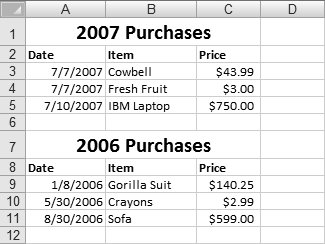

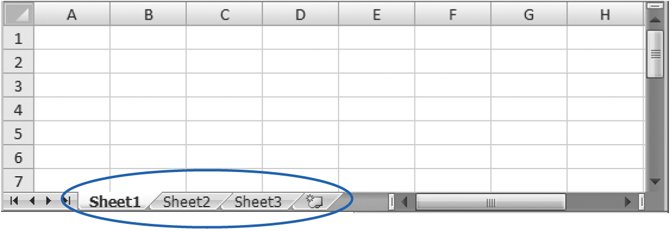
 Cells
Cells 
